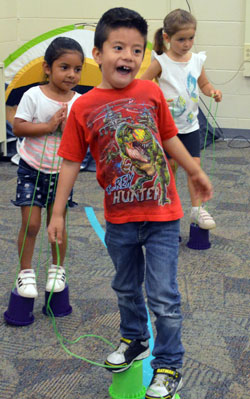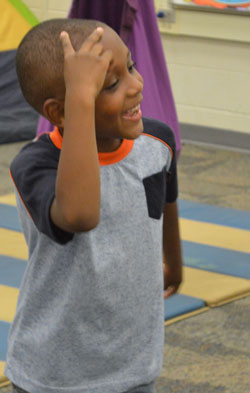Kindergartners sat on the classroom carpet on a recent Tuesday morning, ready to start a day filled with words, numbers, songs and crayons. But the chatty, energetic students knew they would also have time for a little jumping, stomping, flopping onto beanbags, balancing and tossing.
At West Elementary, students have a new sensory room where they can let loose and move.

The kindergarten chatter included:
“I like the trampolines!”
“Me too!”
“I like the Sit ‘N Spin!”
They soon headed to the transformed classroom space where they moved from trampolines to beanbag toss, to balance boards to walking with cups on their feet and spinning on Sit ‘N Spins.
The room was created after West Elementary kindergarten teachers expressed concerns about increased academic requirements in kindergarten resulting in less play.
Teachers Julie Merrill, Dawn Brunik and Karen Dunn, who planned the space, said they are already seeing the benefits of 15 minutes of movement every day– in addition to recess.
“We are waking our brains up,” Brunik tells her students as they play in the room after a quick breakfast in the room.

Movement Benefits Learning
Merrill and Brunik attended a seminar called “Purposeful Play” led by educator Jacque Groendyk, who owns the company Brains in Motion, where they learned about the connection between movement and learning. Much of it they already knew: students sitting for long stretches aren’t able to pay attention, stay on task or learn what they need to.
“We are all seeing the articles about how academic kindergarten is and how kids are just not getting what they need,” said Merrill. “We know kids are sitting with tablets… They are not outside playing like we were when we were kids.”
But if students aren’t developing fine and large motor skills through physical activity, they suffer academically as well, she said.
“If you miss these developmental steps in your brain you can spend all kinds of money on academic interventions, but you are not going to make much progress,” Merrill said.
Since adding the sensory room, they are already seeing positive results.
“The biggest thing I see is their attention in class is so much better,” said Merrill, who breaks up a 90-minute block of literacy with time in the room.

Developmental Kindergarten Added Too
The room is part of a larger effort to meet the needs of the school’s littlest learners. West this year is also piloting a developmental kindergarten class — the only in the district — for students who have late birthdays or who aren’t quite ready for the rigors of kindergarten. While students, by law, must turn 5 by Sept. 1 to start kindergarten, parents can sign a waiver to enroll children with birthdays up unto Dec. 1. Several students with birthdays later than the deadline enroll each year. Developmental kindergarten is ideal for many of them because it is more play based and meant to be fall between preschool and regular kindergarten.
“They just need that extra year of development,” said Dunn, who teaches the class.“It all has to do with the fact that they aren’t yet academically ready. They will do great with extra time. It’s just that gift of time.”
While still a full-day program, students in developmental kindergarten will attend regular kindergarten next year.
















